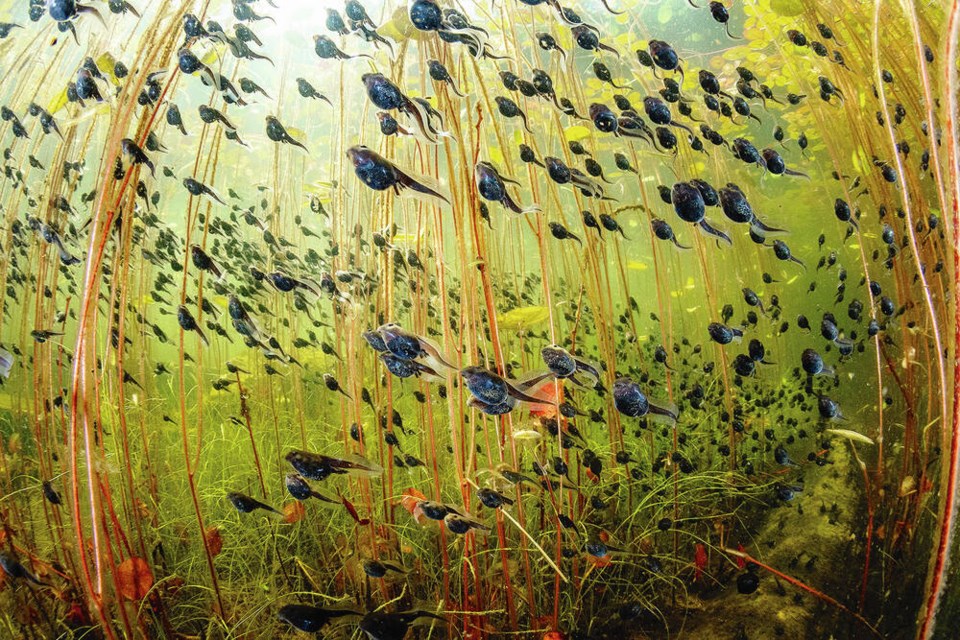A Nanaimo photojournalist has been named the 2024 Wildlife Photographer of the Year by a jury at the U.K.’s Natural History Museum.
Shane Gross’s photo The Swarm of Life, an image of western toad tadpoles swimming in the sunlight among lily pads in a lake near Campbell River, earned him the grand prize. There were 59,228 entries from 117 countries and territories.
“I’m beyond honoured,” Gross told the Times Colonist on Thursday from London. “I’m so happy to be able to highlight the beauty of Â鶹´«Ã½Ó³»Island and our wetlands.”
Gross, whose photo also won in the wetlands category, called taking the photo “the easy part.”
“The hard part, the much more important part, will be trying to leverage this win and everything else at our disposal to protect wetlands and other overlooked ecosystems.
“With this photo I’m hoping to tell a story of hope,” said Gross. “Here you have a place that’s still relatively pristine and has abundant life. There are millions of tadpoles in this lake. That to me is a very special and hopeful thing.”
British Columbians will be able to see the photo up close when the Wildlife Photographer of the Year exhibition runs at the Royal B.C. Museum early next year, from Feb. 14 to April 17. It will also be on display at the Royal Ontario Museum in Toronto starting Dec. 21 of this year.
Gross, who describes himself as a marine conservation photojournalist, said his childhood passion for sharks grew into a love for everything that lives underwater. “Telling long-form narratives about the ocean and humans’ impact on her, both positive and negative, are what drives [me],” he said.
He captured the winning photo while snorkelling through floating aquatic plants in Cedar Lake, carefully positioning himself near the bottom without disturbing the silt and algae.
Gross said he snorkelled in the lake for several hours before finding just the right spot, following the trails cleared by beavers through the carpets of lily pads on the surface.
Competition judge Tony Wu said Gross “immerses” the viewer in an “epic migration of tiny tadpoles, a scene that most of us would have never imagined existed.
“By putting us in the midst of this movement of millions, they highlight the fact that beauty and magic exist everywhere, even in the most mundane of settings.”
Jury chair Kathy Moran said the judges were “captivated by the mix of light, energy and connectivity between the environment and the tadpoles.”
Every day, western toad tadpoles swim up from the safer depths of the lake, dodging predators and trying to reach the shallows to feed.
The tadpoles start becoming toads between four and 12 weeks after hatching, but an estimated 99% do not survive to adulthood. Those that do face threats from roads, pesticides and herbicides and the chytrid fungus.
Island-based filmmakers Maxwell Hohn and Russell Clark made a mini-documentary film on the tadpoles in 2020, called Tadpoles: The Big Little Migration.
They described millions of plump tadpoles moving en mass in their remarkable daily migration from the depths of the lake to its oxygen-rich shallows, where they feed on algae to support the metamorphosis to western toad.
They congregate in clouds and use lily pads as cover from predators during their journey. A few hours later, they turn around and do the same route in reverse. The tadpoles repeat this daily migration throughout their metamorphosis.
The small toadlets eventually emerge from the water and into the forest, where they face an uncertain, often perilous future. After habitat loss due to agriculture, logging and other developments, being run over by vehicles is considered a major threat.
Western toads are yellow-listed in British Columbia, meaning they are secure but have a restricted distribution or perceived future threats and are associated with habitats that are becoming more rare.
Gross has entered the Wildlife Photographer of the Year competition every year since 2011, but this is the first time he has won a category.
John E. Marriott of Canmore, Alta., was the only other Canadian winner. His photo of a family of lynx in the Yukon won the Animal Portraits category.
Alexis Tinker-Tsavalas of Germany won the Young Wildlife Photographer of the Year award with Life Under Dead Wood, a portrait of a tiny springtail insect on a slime mould.
>>> To comment on this article, write a letter to the editor: [email protected]



